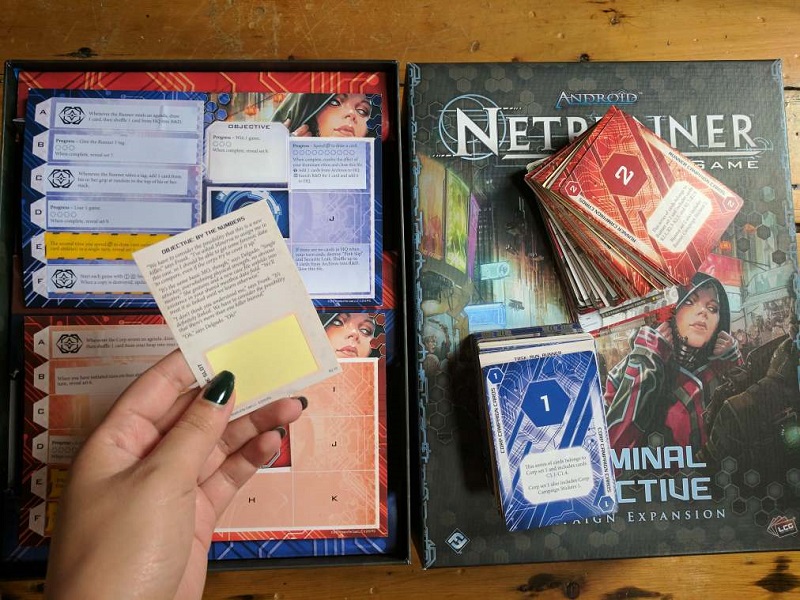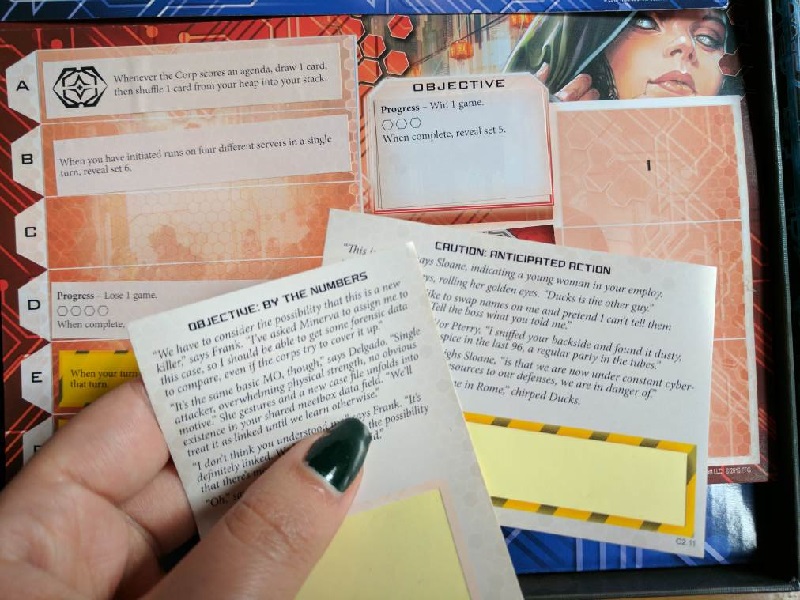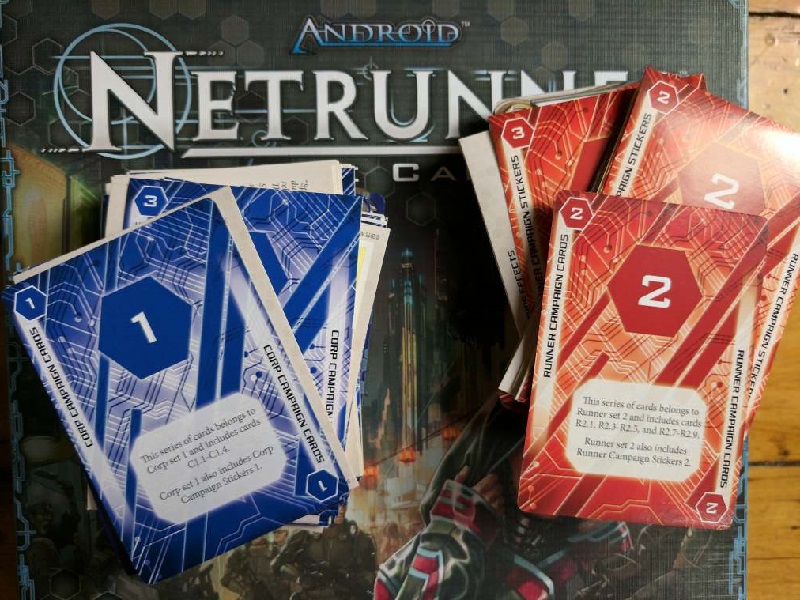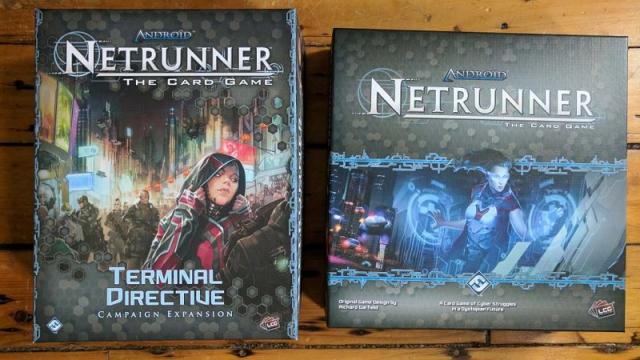Cyberpunk card game Netrunner recently received a murder mystery expansion, Terminal Directive. It’s a novel twist on an already-fantastic game and its first story-based campaign. The obvious question: How does a narrative of cyberwarfare unravel through a card game that requires shuffling decks? The answer is, slowly, in fits and starts and in spite of a frustrating balancing act of ever-changing gameplay modifiers.
Netrunner: Terminal Directive
I regularly describe Netrunner as “the shit” and “infinitely superior to Magic: The Gathering“. As a fan of science-fiction, I will also describe it to select few as “Neuromancer‘s spiritual successor”. It’s an asymmetric, collectible card game that has one player, the hacker, attempting to breach an evil corporation’s security system, puppeteered by a second player. The hacker’s objective is to break through the corporation’s “ICE” programs (which stands for the ironically bureaucratic Intrusion Countermeasures Electronics) and gain access to its data.
The corp, on the other hand, plays defensively. They must stave off the hacker’s “runs” by draining them of resources or installing bothersome ICE barriers. Some corp decks are all about misdirection, so instead of mining sweet data at the end of a run, the hacker might encounter traps.
The game bills itself as a cyberwarfare card game set in a dystopian future. I love its cards’ tongue-in-cheek critiques of capitalism. One card, “Hedge Fund,” has players spending five credits to gain nine. The card reads, “An ingenious device by which the rich get richer while every other poor SOB is losing his shirt.” A little more William Gibson, the “Stimhack” card super-powers a hacker during a run, but forces them to suffer brain damage afterwards.

Netrunner
Terminal Directive converts these Gibson undercurrents into a hacker mystery narrative, albeit a fragmented one. Its introduction in the manual reads like Neuromancer fan fiction: “She was glad the bodies were gone, even if the smell still lingered … Two techs bagged the heavy sledgehammer while a low-hovering camdrome gathered some last-minute images.” A bioroid — a robot that usually does no harm — may have committed a series of murders. The corp and hacker (there are two identities of each to choose from) race to investigate what happened, so they can either replicate or destroy the apparent killer bioroid.
That narrative takes the player through an episodic series of Netrunner games. After assembling decks from the Netrunner base set and Terminal Directive expansion, both players unveil the first campaign card set for their decks (further sets must be kept secret for later). With each unveiled set, players shuffle new cards into their decks. Some open sneak doors through the corporation’s network or siphon money away from the hacker.
New sets also contain cards with quippy narrative sequences that advance the plot, depending on which set is revealed in what order. They also add new sticker sheets that add additional rules to cards. To progress and unveil more sets, players must fulfil objectives like winning with co-investigator Inez Delgado’s card in play or, a bit more dull, winning three games.
As the game progresses, more restrictions govern gameplay as more cards are added to each deck. For example, after unveiling set 2, I received two cautions: I must attempt a hack on each turn and have at least three credits in my pool when each turn ends. My turns looked a lot different. It forced me to play more aggressively, which was fun. But if I failed to play by the rules, I’d have to reveal another set, which could contain cards with negative effects.

Netrunner
Also new, Terminal Directive comes with personal access devices (PADs), sheets of paper on which players note effects, cautions, objectives and tasks. Those are all printed on stickers. They are not removable. And, on occasion, a set will direct you to “destroy” a card, or place a sticker on it. Because these are one-use stickers, it appears that the entire Terminal Directive campaign expansion is one-use, but I have yet to confirm this (I have reached out to Asmodee for clarification.)
With ten sets, each full of directives and new cards, Terminal Directive can feel cluttered. Balancing four effects, two cautions, an objective and several tasks on top of a strategically-demanding Netrunner game is not an easy feat. This means the game’s remarkably well-written narrative sequences take a backseat to the juggling act of rule-abiding gameplay.
I did not yet complete the campaign, but four hours in, the narrative feels like a light overlay, a bit more of a gimmick than a game-mover. It might have been better-integrated if new card sets were more obviously tied to narrative advancements, but that’s the difficulty of a campaign card game — card decks are shuffled. So, for example, the corp must advance their “evidence collection” agenda card. This means adding tokens to a card they possess instead of, for example, achieving smaller objectives that reveal bits of evidential information.

Terminal Directive
Terminal Directive‘s Gibson fanfiction, or the mechanics necessary to advance it, work against Netrunners gameplay. Players for whom Netrunner‘s already-complex ruleset is second nature will enjoy the added challenges and story. New players might balk upon opening Terminal Directive‘s box and seeing the mess of one-use stickers and “DO NOT OPEN” decks.
Terminal Directive‘s narrative ambitions felt bold and daring — also, in line with Netrunner‘s cyberpunk roots. But Netrunner is already a reimagining of narrative science-fiction. You’re a hacker, weaponising viruses and ICE-breakers to steal data, or you’re a malevolent corporation fending off infiltrators. By design, it’s deeply layered, grabby in its strategy demands and streamlined enough for players to get very, very into it. Three times throughout one Terminal Directive campaign game, I fell into the corporation’s “Snare,” traps laid out behind layer upon layer of ICE. They’re just a regular Netrunner cards. And I screamed, because, well, Netrunner inspires that.
So, while recalling Terminal Directive to the fiction texts that inspired it is a good idea in theory, doing so with a fragmented plot and cluttered gameplay goals actually took me out of an already-hypnotic, and preeminently successful re-imagining of cyberpunk fiction.

Comments
2 responses to “Netrunner’s New Murder Mystery Campaign Messes With A Good Thing”
I’ve played a lot of Netrunner. Just plain silly amounts. Terminal Directive is made for newer players looking for that next step after buying the core set. So it’s very hard for me to give an accurate review of it for the target audience.
However, as something to bring the game back to basics after the nuttiness the metagame has become, it’s alright. Oh, the story is a disjointed mess and there are more than a few misprints/rules errors on cards.
This is a really weird product to recommend. Anyone who plays Netrunner at my level is going to pick it up because it has new tournament legal cards. Anyone who wants to play Netrunner could consider picking it up to spice up their game a little. Basically, if what you’re after is “more Netrunner” Terminal Directive provides.
I literally could not finish reading this article because the cards aren’t sleeved and the corner of the card is actually bent in that close up picture… *shudder*
Edit… tried again, realised that card is actually a sticker of some sort, phew. Then noticed the stickers stuck on the sheet in the background, AND THEYRE ALL CROOKED… THATS EVEN WORSE!!!